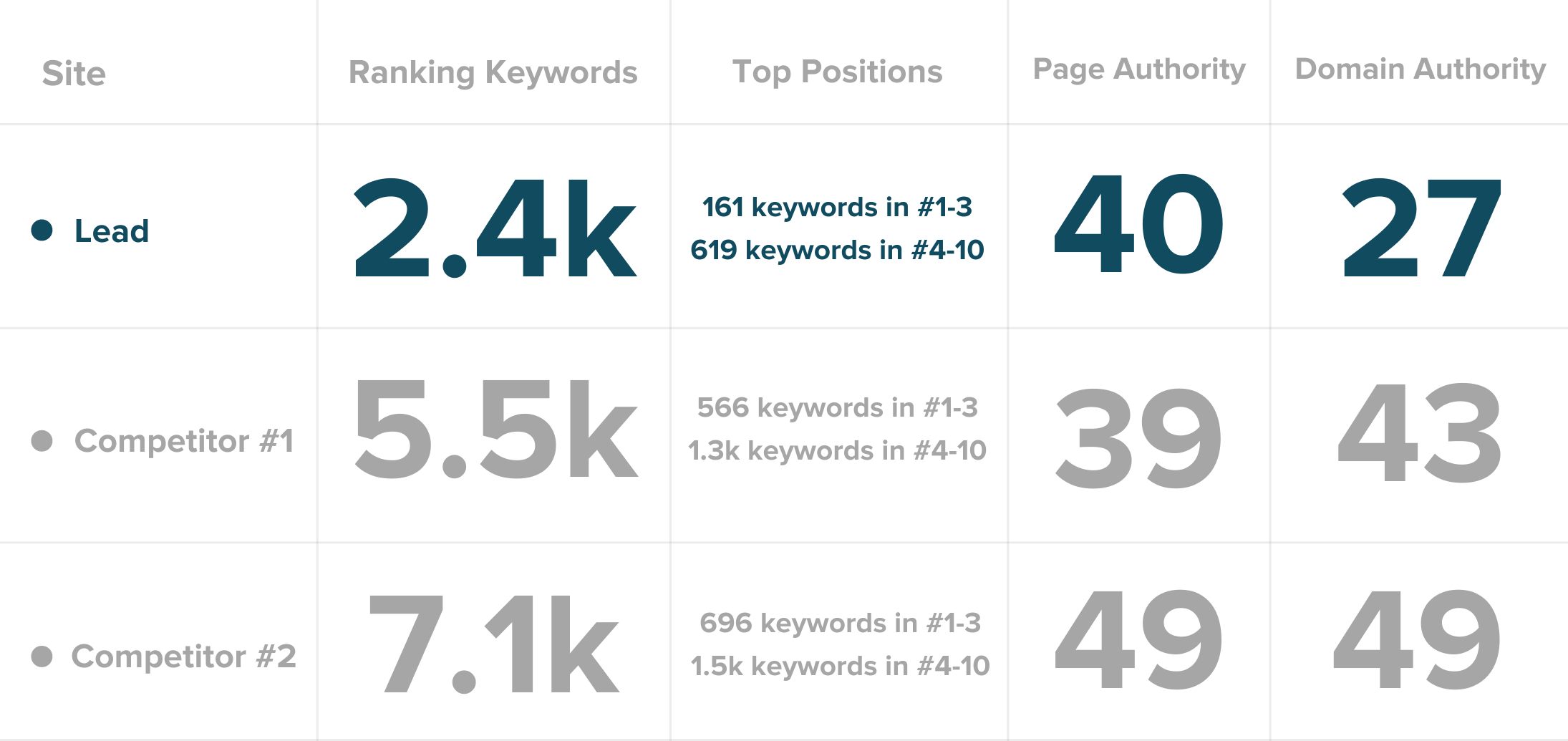“Who are my competitors?”
It’s something business leaders, marketers, and salespeople alike ask themselves regularly. You might have thought about it yourself if you recently lost a sale to one of your challengers. Yet chances are good that you might not realize how your competition stacks up against you in terms of keywords.
Let me explain.
First, consider how most people find out about new brands. They type keywords into a search engine and check out the results, right? If a result catches their eye, they click on it. According to Search Engine Journal’s findings, the top three positions get more than half of those clicks. Consequently, it’s important that one of your site’s pages be front and center when a potential lead types in a keyword that's relevant to your business.
In marketing parlance, we refer to this as keyword ranking. It’s very important if you want to steer organic traffic and qualified leads into your sales funnel. The more relevant keywords your site ranks for, the more traction you can gain in the market. Unfortunately, the reverse is true, too. If a competitor outranks you, that company will be in a better position to build awareness and earn sales.
Here’s the kicker, though: Most companies have never tried to identify their keyword competitors. They just assume they know. I’ve had executives, entrepreneurs, and founders ask me to check out their sites’ keyword rankings. They were shocked to learn that businesses that hadn’t been around as long as they had were getting better keyword positioning. And they were understandably eager to learn more about how to rank higher than their competitors.
Bringing Awareness via a More Thorough Competitor Analysis
After helping so many people get insights into their true digital competition, we decided to add the practice into our outreach efforts. Instead of sending a general email to all inbound and outbound leads, I often send a small customized keyword comparison chart. The chart shows how many keywords the company and its biggest keyword competitors are ranking for.
I use our paid version of Moz to complete the evaluations and put the charts together. It takes a bit of extra effort, but that’s OK. Leads tend to be appreciative when they receive personalized keyword analysis charts like this:

Tips for Identifying and Outranking Your Competitors in Search
It's time to take your keyword competitors seriously. Every day, they’re stripping you of valuable prospects. That’s not good for business. Therefore, I advise taking the following steps to close any keyword ranking gaps between you and other players in your industry.
1. Learn how to research your competition online.
As I mentioned before, I like to use the keyword research tool Moz offers to figure out top keywords. It’s worth learning how to research keywords correctly and confidently. That way, you can begin to measure your site’s position for a wealth of keywords.
What should you do if you find out a competitor is ranking higher than you for pertinent keywords? Dive into the competitor’s website. Nose around. What pages are ranking highest for the keywords you want to compete for? What type of content are they publishing? Subscribing to a competitor’s newsletter or blog can be a terrific way to find out what’s happening on the other side of the fence.
2. Create new content that’s rich with the keywords you want to outrank competitors for.
At this point, you should have a good idea of the most valuable keywords you’d like to own — or, in case you already own them, keep. Now, your job is to create new content that uses those keywords and will live on your site. Be sure your copy contains mentions of these keywords in titles, headers, meta descriptions, alt text, and body copy.
There’s a quick caveat, though: Write first for your readers, not your keywords. Far too many companies push out content that’s keyword-rich but insight-poor. But content like that is not going to be worthwhile to anyone and might end up harming your brand reputation (and could end up hurting your rankings because it's providing a poor user experience).
3. Update your past content by strategically infusing your top keywords into copy.
One of my colleagues, Tony Patrick, wrote a great piece for Content Marketing Institute on the topic of historical optimization. It’s a method of freshening up your old content, and one way to update older content involves peppering it with specific, highly relevant keywords.
For example, you might find that an article no longer seems as fitting as it did when it was first published. Rather than archiving it, give it a facelift. With some tactical massaging and appropriate keyword insertions, you can turn it into a high-performing content item that helps you boost your rankings and gain a competitive advantage.
I’m not suggesting that you aren’t aware of your competition for business. With that being said, there are several types of competitors in marketing. Perhaps your real challengers in search results aren’t who you suspect. There’s only one way to find out.
If you don’t have the time, click below to schedule a call! We’d be happy to do a little keyword research legwork on your behalf.









